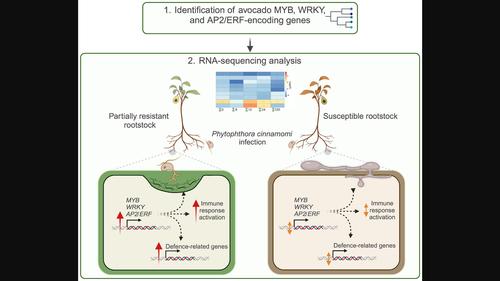当前位置:
X-MOL 学术
›
Mol. Plant Pathol.
›
论文详情
Our official English website, www.x-mol.net, welcomes your feedback! (Note: you will need to create a separate account there.)
Comparative transcriptional analysis of Persea americana MYB, WRKY and AP2/ERF transcription factors following Phytophthora cinnamomi infection
Molecular Plant Pathology ( IF 4.9 ) Pub Date : 2024-04-09 , DOI: 10.1111/mpp.13453 Alicia Fick 1, 2 , Velushka Swart 1, 2 , Aureliano Bombarely 3 , Noëlani van den Berg 1, 2
Molecular Plant Pathology ( IF 4.9 ) Pub Date : 2024-04-09 , DOI: 10.1111/mpp.13453 Alicia Fick 1, 2 , Velushka Swart 1, 2 , Aureliano Bombarely 3 , Noëlani van den Berg 1, 2
Affiliation

|
Plant cells undergo extensive transcriptional reprogramming following pathogen infection, with these reprogramming patterns becoming more complex when pathogens, such as hemibiotrophs, exhibit different lifestyles. These transcriptional changes are often orchestrated by MYB, WRKY and AP2/ERF transcription factors (TFs), which modulate both growth and defence‐related gene expression. Transcriptional analysis of defence‐related genes in avocado (Persea americana ) infected with Phytophthora cinnamomi indicated differential immune response activation when comparing a partially resistant and susceptible rootstock. This study identified 226 MYB , 82 WRKY , and 174 AP2/ERF TF‐encoding genes in avocado, using a genome‐wide approach. Phylogenetic analysis revealed substantial sequence conservation within TF groups underscoring their functional significance. RNA‐sequencing analysis in a partially resistant and susceptible avocado rootstock infected with P. cinnamomi was indicative of an immune response switch occurring in either rootstock after 24 and 6 h post‐inoculation, respectively. Different clusters of co‐expressed TF genes were observed at these times, suggesting the activation of necrotroph‐related immune responses at varying intervals between the two rootstocks. This study aids our understanding of avocado immune response activation following P. cinnamomi infection, and the role of the TFs therein, elucidating the transcriptional reprogramming disparities between partially resistant and susceptible rootstocks.
中文翻译:

肉桂疫霉感染后美洲鲈 MYB、WRKY 和 AP2/ERF 转录因子的比较转录分析
植物细胞在病原体感染后经历广泛的转录重编程,当病原体(例如半生物营养生物)表现出不同的生活方式时,这些重编程模式变得更加复杂。这些转录变化通常由 MYB、WRKY 和 AP2/ERF 转录因子 (TF) 精心策划,它们调节生长和防御相关的基因表达。鳄梨防御相关基因的转录分析(美洲鲈 ) 感染肉桂疫霉 当比较部分抗性和易感砧木时,表明了不同的免疫反应激活。这项研究确定了 226MYB , 82WRKY ,以及鳄梨中的 174 个 AP2/ERF TF 编码基因,使用全基因组方法。系统发育分析揭示了 TF 组内大量的序列保守性,强调了它们的功能意义。感染了部分抗性和易感牛油果砧木的 RNA 测序分析肉桂松 表明分别在接种后 24 小时和 6 小时后任一砧木发生免疫反应转换。不同簇的共表达TF 在这些时间观察到基因,表明在两个砧木之间以不同的时间间隔激活死体营养相关的免疫反应。这项研究有助于我们了解鳄梨免疫反应激活后肉桂松 感染,以及转录因子在其中的作用,阐明了部分抗性和易感砧木之间的转录重编程差异。
更新日期:2024-04-09
中文翻译:

肉桂疫霉感染后美洲鲈 MYB、WRKY 和 AP2/ERF 转录因子的比较转录分析
植物细胞在病原体感染后经历广泛的转录重编程,当病原体(例如半生物营养生物)表现出不同的生活方式时,这些重编程模式变得更加复杂。这些转录变化通常由 MYB、WRKY 和 AP2/ERF 转录因子 (TF) 精心策划,它们调节生长和防御相关的基因表达。鳄梨防御相关基因的转录分析(



























 京公网安备 11010802027423号
京公网安备 11010802027423号